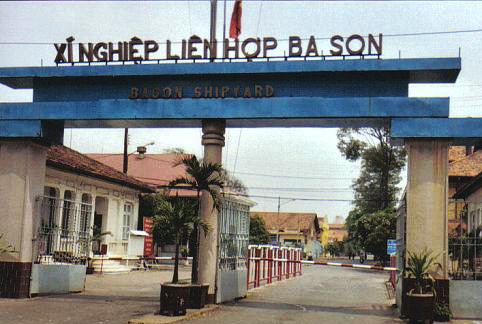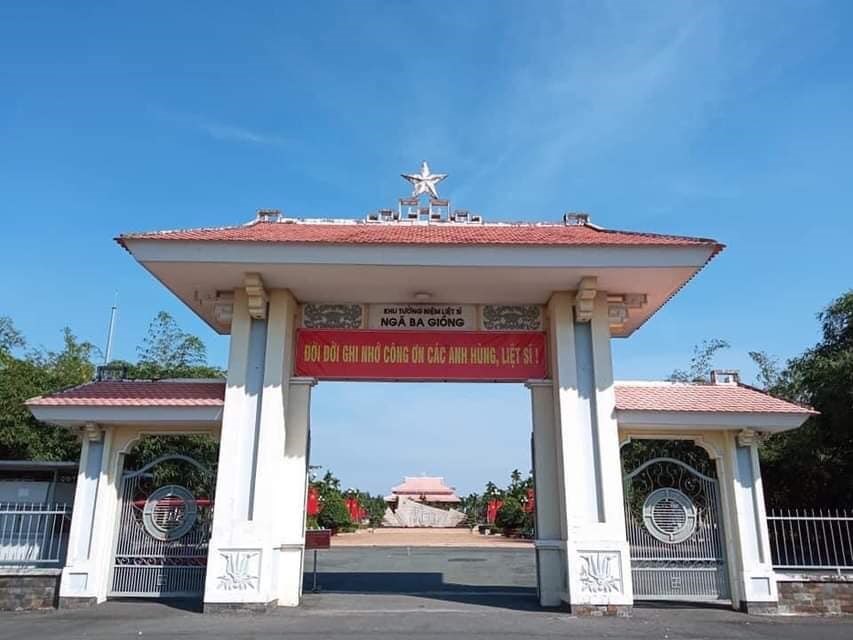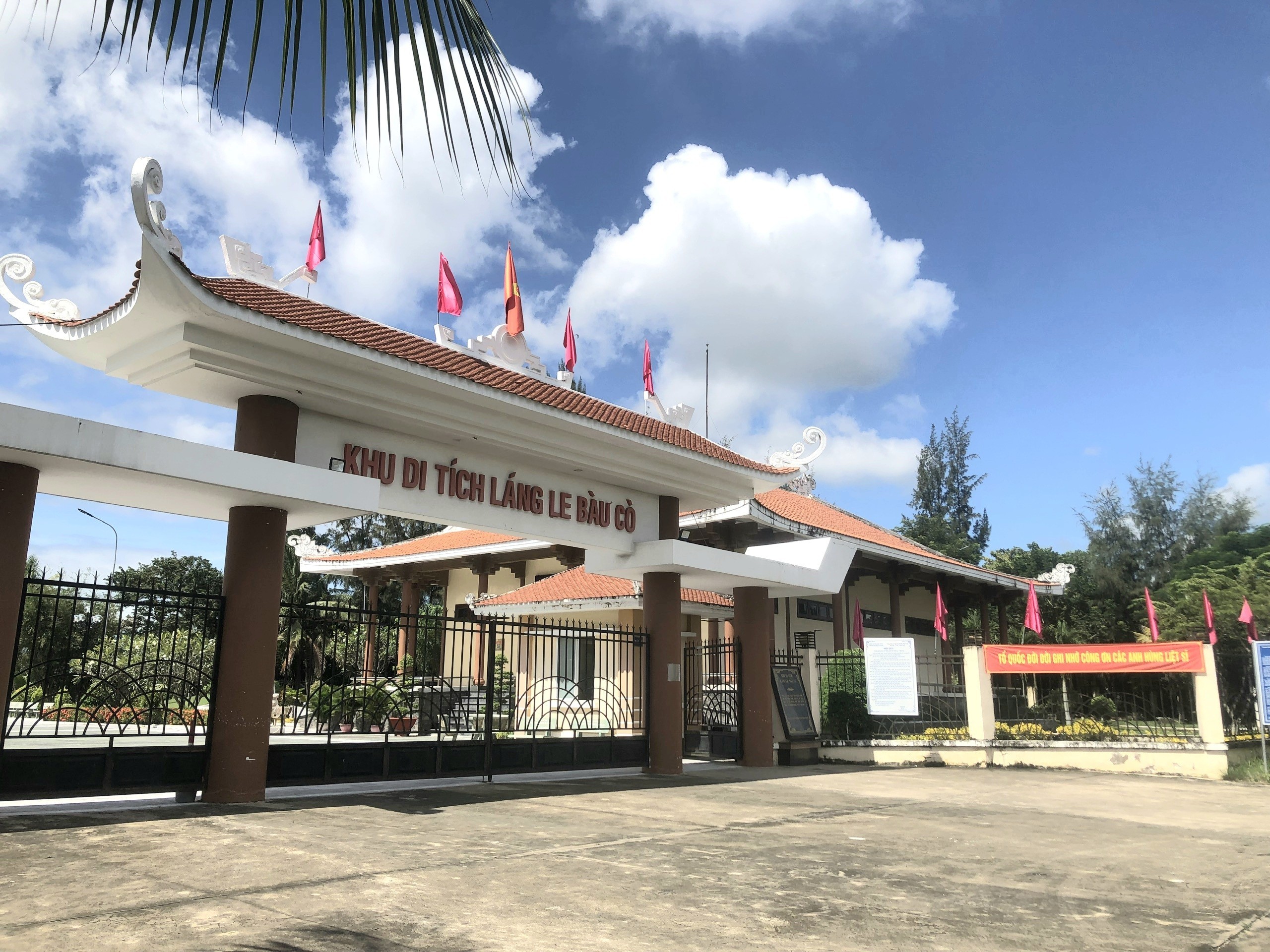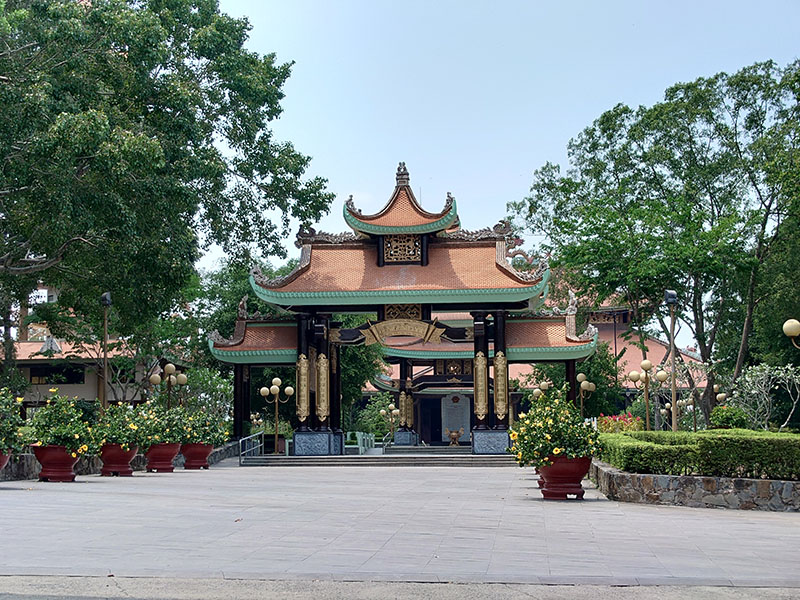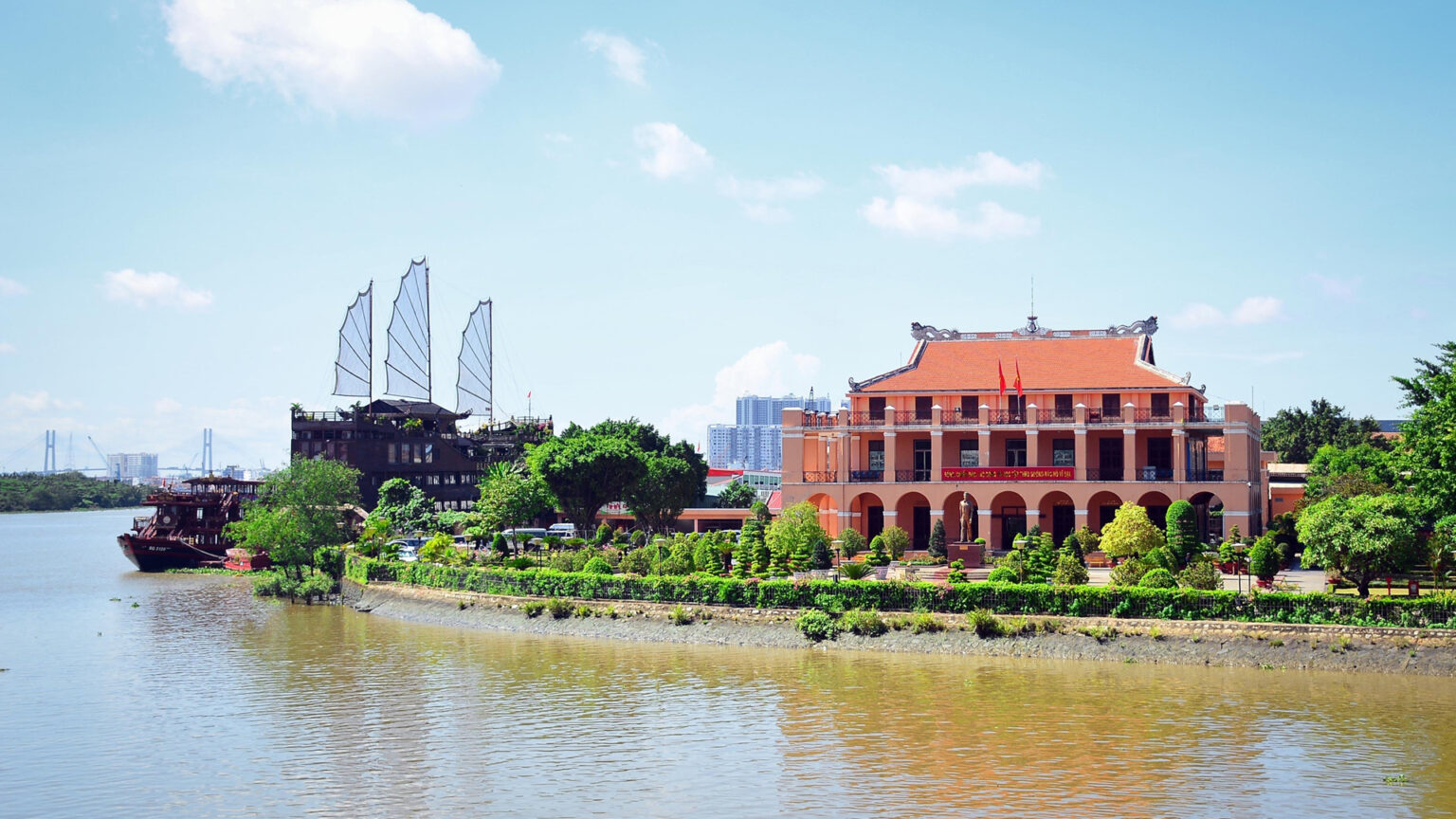Relic point Vietnam
Việt NamMemorial site for President Ton Duc Thang in Ba Son area
The memorial site for President Ton Duc Thang is located on the campus of Ba Son Enterprise Union, which today is a large shipbuilding and repair workshop, located at 2 Ton Duc Thang Street, Ben Nghe Ward, District 1, City. Ho Chi Minh. This is a historical site with many meanings. The mechanical workshop at number 323, Street 12 within the factory campus is where mechanic Ton Duc Thang (later President of Vietnam - from 1969 to August 30, 1980) worked and participated in revolutionary activities. in the years 1915 - 1928. In 1861, France defeated Chi Hoa Fort and occupied Saigon. On April 28, 1863, the French government signed a decree officially establishing the Ba Son Shipyard (Arsenal) under the French Ministry of the Navy. Because of that importance, in 1884 the French government built another large dry dock to serve as a ship repair base for the French fleet in the Far East. After the Geneva Agreement was signed, the French army withdrew from Indochina. On September 12, 1956, France transferred Ba Son to the Saigon government navy. Under the old Saigon regime, Ba Son Waterworks was renamed Navy Factory, placed directly under the Ministry of National Defense. After April 1975, the Navy factory was taken over by the Revolutionary government and was renamed Ba Son Enterprise Union, under the Ministry of National Defense to this day. Ba Son Waterworks is the largest factory in Saigon, one of the places with the largest concentration of workers in Vietnam in the early years of the century. In order to train native electricians and mechanics to supply French companies and factories in Saigon, on February 20, 1906, the French government signed a decision to establish the Asian mechanical school in Saigon (Eécole des mécaniciens). Asiatiques de SaiGon - today's Cao Thang Technical School). Ba Son ship repair workshop is a workshop that uses the school's students to practice at the workshop and directly recruits students who have completed their studies at the school. The Saigon Asian Mechanical School and the mechanical workshop of Ba Son Water Factory at that time were associated with the first revolutionary activities of revolutionary Ton Duc Thang. After finishing primary school in his hometown: An Hoa village, My Hoa Hung commune, Dinh Thanh district, Long Xuyen province (now My Hoa Hung commune, Long Xuyen town, An Giang province), young man Ton Duc Thang decided to intending to go to Saigon to find a job and orient his life to the working class. Uncle Ton took the entrance exam to the Asian Mechanical School for the course 1915 - 1917. Currently, at the Ho Chi Minh City Museum, there is still an original book registering students enrolled in courses at this school from 1906 to 1966. . In August 1920, he returned from France to Saigon to work as a worker for KROFF and CIE. Influenced by the Russian October Revolution and learning a lot from the struggle experiences of French workers, Uncle Ton campaigned to establish the first Red Union in the city. The secret union developed among workers of Ba Son factory, Faci company, Cho Quan lighting house... From 1920 to 1925, the number of members increased to 300 people with Uncle Ton as president. This is the first Trade Union organization in Vietnam with the purpose of supporting and fighting to defend the rights of workers and fight against capitalist imperialism. Under the leadership of the Red Congress, the struggle movement of city workers during this period exploded strongly. Typically, the strike demanding increased wages and half-day off on payday of Ba Son Waterworks workers broke out on August 4, 1925 and lasted until August 12, 1925. The strike was successful, but in order to support the struggle movement of Chinese workers and working people by "holding back" the battleship J. Mi-S-Le under orders from the French government, it needed urgent repairs to bring went to China to suppress the revolutionary movement. The strike of Ba Son workers continued in the form of a walkout, prolonging the repair of the warship for up to 4 months. Thus, this struggle, in addition to demanding economic rights and improving working conditions, also has a political nature, especially activating the sense of international solidarity of the Vietnamese working class. The strike of Ba Son workers under the leadership of the Red Trade Union organization opened a new period of struggle for the Vietnamese working class. The period of struggle was organized, led and supported by all workers and working people. The struggle movement has gone from spontaneity to a level of self-awareness, which is a good basis for accepting Marxism-Leninism. On November 19, 1975, as President, Uncle Ton visited Ba Son factory and recorded it in the factory's souvenir book. On August 12, 1993, the Ministry of Culture issued a decision to recognize Ba Son as a historical relic. Source: Ho Chi Minh City Youth Union
Ho Chi Minh City 4743 view
Hoc Mon District Palace
Hoc Mon District Palace is located at No. 1, Ly Nam De Street, Hoc Mon Town, (next to the District People's Committee headquarters) and is the place where many outstanding fighting events have been recorded throughout the long history from 1885 to the Southern days. Complete liberation of the People of 18 Betel Garden Villages. After defeating Chi Hoa Fort, the French colonialists built a 3-storey wooden house here to use as a military post. When Tran Tu Ca took office as Governor of the Palace, he used the Station as the Palace of Binh Long district. Originally a cunning drunkard of the French colonialists, Tran Tu Ca was led by a group led by Mr. Phan Van Hon (Quan Hon) and Nguyen Van Qua (Chanh Lanh Binh) of nearly 1,000 insurgents who came to burn the District Palace, captured and head cut off in the middle of the market. That was February 8, 1885, At Dau Tet. Afterwards, Hoc Mon District Palace was rebuilt with a blue stone foundation, brick walls, and a defense system from the upper floors to the fence. The architecture is similar to the Military Fort, so the locals call it Hoc Mon Fort. Tran took over from Tran Tu Ca as Governor of Ngon district, moving to Tra District and then Tho District. This was a long period of time when the people of the Hoc Mon region suffered from many cruel and despicable scenes from the French colonialists and their oligarchic henchmen mentioned above. With the indomitable tradition of Hoc Mon people. On June 4, 1930, around 6 a.m. in front of the District Palace, hundreds of Hoc Mon people protested demanding "abolition of poll tax, reduction of license and market taxes, and granting land to poor farmers." Tra District invited the leaders into the Palace to negotiate, but they cunningly arrested them, including Mr. Le Van Uoi (Secretary of Tan Thoi Nhi Commune), who was the leader of the protest. People were undaunted and fiercely demanded that Tea District release those detained. The protest group became more and more crowded, the fighting spirit spread somewhat, causing Tra District to give in. On the one hand, they released the detained people, on the other hand, they called the officials in Saigon for help. 2 hours later, the struggle was led by two men, Blachole and Nobbot, who opened fire on the protest group, causing many casualties. But the most impressive historical event at Hoc Mon District Palace was the Southern Uprising on November 23, 1940. Hoc Mon Fort is very solid, built of green stone like a fortress, about 15 meters high, has a gun emplacement and a defense system with battlements guarded by a platoon of green soldiers. On November 22, 1940, France reinforced one more platoon to deal with the situation. On the afternoon of November 22, 1940, Mr. Do Van Coi's army broke into the town, disguised as civilians, ambushed behind the Station waiting for orders to rob the Station. Another army wing has the task of destroying bridges, cutting down trees blocking roads, and occupying offices and houses... The army wing from Phuoc Vinh An, Tan Thong, Tan An Hoi, Tan Phu Trung is led by Mr. Pham Van Sang and Dang Cong Binh commanded, started from Ben Do hamlet, attacked the house, killed 1 person, collected 4 guns, and took control of the situation here (Tan Phu Trung). Immediately this army was ordered to pull back to Hoc Mon. The Long Tuy Thuong army was commanded by Mr. Bui Van Hoat. The army of General Long Tuy Trung was commanded by Mr. Do Van Day and Le Binh Dang. At around 24:00 on the night of November 22, 1940, the sound of artillery fire had not yet been heard in Saigon. After consulting, the army commanders united to attack the enemy's post. Immediately the troops headed straight to Fort Hoc Mon, where District Chief Bui Ngoc Tho resided. Two insurgents named Nghe and Kinh volunteered to enter the front gate and sacrificed their lives. Insurgents from all directions rushed into the Fort like water bursting its banks. Faced with the power of the insurgents and the masses, the soldiers in the Station no longer had the spirit to resist and fled in disarray. The insurgents completely occupied the inside of the station, but upstairs, the enemy still stubbornly used guns to shoot sporadically, at the same time calling Saigon and Thu Dau Mot for emergency help. Because he was eager to capture the name of Tho District, comrade Do Van Day climbed up to the upper floor of the Station by clinging to the gutter. Halfway up, he was hit by bullets, the comrade fell and died later. The battle was at a standstill when enemy reinforcements arrived. Unable to hold out, the insurgents withdrew from the town, dispersed to the villages, the armed forces withdrew to Ben Do hamlet (Tan Phu Trung) and then moved to My Hanh hamlet (Duc Hoa). Although the attack on Hoc Mon Fort (later called Hoc Mon District Palace) failed, it left a deep impression in the hearts of all civilians admiring the courage of revolutionary soldiers in the fight against colonialism. steal the country. During the historic Ho Chi Minh campaign, at 7:00 a.m. on April 30, 1975, Hoc Mon town was completely liberated, the National flag fluttered above the District Palace, where District Chief Nguyen Nhu Sang and his gang sai has been running away since last night. Today, Hoc Mon District Palace is chosen as the District Museum, where many documents are displayed, illustrating the ups and downs of historical periods as well as the revolutionary fighting spirit of the army and people in Hoc Mon district over the past two years. resistance war against French colonialism and American imperialism. A monument placed in front of the Hoc Mon District Palace relic represents the indomitable sacrifice of the army and people of 18 Betel Garden Villages, recognized as a national historical and cultural relic. Source: Hoc Mon District People's Committee
Ho Chi Minh City 8910 view
WARRIORS' MEMORIAL AREA AT THREE GIONG FORCES, NATIONAL HISTORICAL MONITOR
Nga Ba Giong relic is a revolutionary historical relic located in Hamlet 5, Xuan Thoi Thuong commune, Hoc Mon district. Surrounded by three roads: Phan Van Hon, Nguyen Van Bua and Provincial Road 19. Nga Ba Giong relic site is a memorial site for historical events in two wars against foreign invaders. Recognized as a national historical site in 2002. Giong Junction (also fully known as Giong Bang Lang Junction) is located in Xuan Thoi Tay village, part of 18 old betel garden villages formed from 1698 to 1731. For a long time, Giong Junction is a place with a folk name that has entered the history of the hometown of 18 betel garden villages of Hoc Mon - Ba Diem. Legend has it that in the past, this place was a relatively high land and a place where many linden trees grew, so this place got its name from there. After the Southern Uprising (November 23, 1940) failed, the French colonialists increased their repression and fierce terror against the revolutionary movement in the Hoc Mon - Ba Diem region. They set up three shooting ranges in Hoc Mon to kill Party leaders and patriotic comrades from their hometown of Hoc Mon and surrounding areas. Giong intersection is the third shooting range to record the heinous crimes of the French enemy and his henchmen against the people of Hoc Mon. Learning from the experience of 2 previous shooting ranges (1 at the old theater in the center of Hoc Mon District, 1 next to the well behind Hoc Mon Hospital today), they executed public shootings, forcing people to come and watch for the purpose of intimidation. revolutionary spirit of Hoc Mon people. But that firing squad backfired. The Hoc Mon people witnessed with their own eyes the cruelty of the French colonialists and the noble sacrifices of the communist soldiers, so their patriotic fire flared up even more fiercely. . For this third shooting range, they did not dare to build it near the center of the District anymore, but moved it to the Giong Junction area as a desolate, sparsely populated area to avoid people's resistance. Here, they built a shooting range with a solid mound of land 12m long, 2.2m high, in front of which were planted 6 shooting posts, each 1.7m high, the shooting direction facing the field (Ba Tram Lac). In 1941, here they secretly executed many times without letting the people see, hundreds of communist soldiers and patriots were killed by them. With the extremely sacred historical significance of Giong Junction, the place that marked the barbaric crimes of the French invaders, the place that demonstrated the indomitable fighting will and noble sacrifices of our comrades and compatriots later on. the Southern Uprising (November 23, 1940); After the complete liberation of the South (April 30, 1975), Hoc Mon district quickly restored and embellished the Nga Giong Junction revolutionary historical relic site to educate traditional generations of youth. This place has become a tourist attraction and a place to organize traditional festivals during major annual holidays of Hoc Mon district and the city, especially the anniversary of Southern Uprising Day (November 23). Currently, with the consent of the city, the district is renovating and building Giong Junction into "Giong Junction Martyrs' Memorial Area". Source: Hoc Mon electronic information portal
Ho Chi Minh City 8497 view
Lang Le Bau Co relic site
Lang Le Bau Co relic site is located in Tan Nhut commune, Binh Chanh district, Ho Chi Minh City. Lang Le Bau Co is associated with the resistance war against the French invasion in 1948 with major battles that went down in history. Lang Le Bau Co relic was recognized as a city-level historical relic in 2003. The reason it is called Lang Le Bau Co relic area is because the name of Lang Le Bau Co relic area was given by local people. The hamlet was established next to the interlaced canals and rivers. Lang Le Bau Co is located inside a large field with many shrimp, crabs, and fish. Along with many species of birds such as mallards, storks, teal, nuthatches, gongs, partridges, herons, and red armpits come to feed here. Therefore, Tan Nhut people call it by the familiar and rustic name Lang Le Bau Co. Lang Le Bau Co relic is considered the gateway to move to the center of Vuon Thom base and attack the enemy headquarters in Saigon. Previously, Lang Le Bau Co relic area was originally a field of overgrown reeds. On April 15, 1948, the French colonialists sent 3 thousand soldiers and many modern weapons to simultaneously attack the Lang Le Bau Co area to destroy the Vuon Thom base. At that time, the revolutionary armed forces in Lang Le - Bau, because of their small force and rudimentary weapons, had the help of local people along with the advantage of terrain. After just over half a day of fighting, it turned to attack, causing the French army to suffer a large number of casualties. The victory at Lang Le Bau Co killed 300 enemies, captured 30 mercenaries, and destroyed many machines, military vehicles, and guns of all kinds of the enemy. However, on our side, there are many officers and soldiers who heroically sacrificed their lives at a very young age. On October 14, 1966, in Lang Le, the Republic of Vietnam Army Ranger Battalion was destroyed by tourist militia. Lang Le Bau Co relic site has great historical significance for the people of Saigon in particular and the whole country in general. Faced with hatred for the French colonialists, Lang Le Bau Co's army and people fought a war of great historical significance that opened the door for our side and the enemy. For our side, the battle opened the door to heroism in a strong resistance position. As for the enemy, they had to retreat into a strategic position and were destroyed. The French colonialists could no longer form a strategy to defeat the Viet Minh. Moreover, at Vuon Thom base, Lang Le Bau Co also took place a determined battle to protect our base and destroy all sabotage plans of the enemy. Lang Le Bau Co relic area, after the Dong Khoi movement in 1960, was also a logistics and springboard for the armed forces to liberate Long An - Saigon - Gia Dinh. To commemorate the sacrifices of our compatriots and soldiers, in 1988 Binh Chanh district built a historical building in Lang Le Bau Co land with an area of 1000m2. Source: Ho Chi Minh City Electronic Information Newspaper
Ho Chi Minh City 13178 view
Cu Chi Tunnels historical relic site
Located about 70 km northwest of the center of Ho Chi Minh City, Cu Chi Tunnels is a miniature of the transformation and creativity of the army and people of Cu Chi during the long and fierce resistance war for 30 years. fight against invaders, win independence and freedom for the Fatherland. With the scale of its feat, Cu Chi Tunnels entered the history of the heroic struggle of the Vietnamese people as a legend of the 20th century and became a famous landmark in the world. With only rudimentary tools such as a hoe blade and a shovel, a unique and one-of-a-kind wonder of fighting the enemy has been created with about 250 km of tunnels spreading like a spider web in the ground, with continuous constructions. with tunnels such as: Trenches, emplacements, fighting nests, bunkers for dining, sleeping, meetings, activities, military medicine, food storage warehouses, wells, Hoang Cam kitchen... The real stories from the tunnels have exceeded human imagination. The tunnel is 3 to 8 meters deep underground, the height is only enough for one person to walk on their knees. The first tunnel at the edge of the forest has an underground well that provides drinking and living water for the entire tunnel area. The well is 15m deep and clear. The tunnel system consists of 3 floors, from the "backbone" radiating countless long and short branches that connect with each other, some branches reaching out to the Saigon River. The first floor is 3m above the ground, resistant to artillery shells and the weight of tanks and armored vehicles. The second floor is 5m above the ground and can withstand small bombs. The last floor is 8 to 10 meters above the ground, which is very safe. The way up and down between the basement floors is arranged with secret hatch covers. Above is discreet camouflage, looking like extruded termite mounds, along the tunnel there are vents. Connected to the tunnels, there are large tunnels for resting, a place to store weapons and food, a well, a Hoang Cam kitchen, a command tunnel, a surgical tunnel... There are also large tunnels and roofs. The roof is airy and cleverly camouflaged for watching movies and performing arts. Also from this tunnel, the US Crimp (trap) operation with 3,000 troops, Sedarfall operation with 12,000 soldiers, with tanks and maximum support aircraft, aimed to turn Cu Chi into a "destruction free zone". destroy" has been smashed. Cu Chi truly deserves the title "land of steel and bronze" through 20 years of persistent fighting. With the value and stature of the victory summed up by the blood and efforts of tens of thousands of soldiers and compatriots, the Cu Chi tunnel base has been recognized by the Ministry of Culture as a special national monument. Since the return of peace, tens of thousands of tourist groups with millions of people of all skin colors and ethnicities around the world have visited Cu Chi tunnels. From General Secretaries of the Communist Party, Heads of State, to politicians, generals, scientists, philosophers, writers, journalists, American veterans... have set foot in the tunnels with all emotions and admiration for the heroic land. A politician in the Federal Republic of Germany said: "For many years I have been skeptical about the struggle of the Vietnamese people. How can a small and poor country defeat a large and rich country like America? But when I came here, going through the 70m tunnel, I was able to answer that question myself." Source: Ho Chi Minh City Historical Relics
Ho Chi Minh City 5059 view
Nha Rong Wharf - Ho Chi Minh Museum (Ho Chi Minh City Branch)
Nha Rong Wharf is one of the historical relics associated with the great President Ho Chi Minh's path to national salvation. Nha Rong Wharf or Ho Chi Minh Museum started out as a major commercial port of Saigon. This trading port is located on the Saigon River and was built in 1863, and more than 2 years later, in 1864, this Nha Rong was completed, on the area near Khanh Hoi bridge. Construction of Nha Rong began on March 4, 1863, by the "Sea Shipping Company" to build a store to serve as a residence for the General Director and a place to sell train tickets. The roof is decorated with a dragon image, in the middle instead of a pearl is a badge with the image of "Horse head and anchor". The "Horse Head" insignia refers to the time when in France, this company specialized in road transport with horses pulling carts, while the "Anchor" symbol symbolizes ships. In 1919, the company was allowed to build a wharf with reinforced cement but could not do so. It took until March 1930 to complete the new wharf, which had only one wharf but was 430m long. In 1955, after the French colonialists failed in Vietnam, Saigon Trade was transferred to the southern government of our country to manage. The government restored the roof and replaced the two old dragons with two other dragons with heads facing outward. With a construction area of nearly 1,500 square meters, the remaining area is a green garden with cool air and a romantic setting of more than 400 precious trees from all over the country gathered here to show off their beauty and fragrance, especially especially the banyan tree of the late General Secretary Nguyen Van Linh and the bodhi tree of the President of India. In 1965, Nha Rong was used by the US military as the headquarters of the US Military Aid Receiving Agency. In 1975, after the country was unified, Dragon House, the symbol of Saigon port, was managed by the Vietnam Seaway Department. Nha Rong Wharf is currently the Ho Chi Minh Museum, Ho Chi Minh City Branch, one of the museum branches and souvenirs about President Ho Chi Minh in the country. Because here, on June 5, 1911, young man Nguyen Tat Thanh (later Ho Chi Minh) boarded a train to work as a kitchen assistant to have the opportunity to go to Europe. Next was the day Uncle Ho left to find a way to save the country in Vietnam. Nha Rong Harbor is a place to preserve many priceless documents and artifacts to help future generations better understand the life and great revolutionary career of the Father of the Nation. The museum is built into 12 galleries with about 170 data, images and artifacts. Not only that, this is also an address for people to come and learn about the life and revolutionary career of Uncle Ho. Nha Rong Wharf is also a destination that attracts millions of domestic and international tourists. From the above great values and meanings, Nha Rong Harbor deserves to be a national historical relic that we need to preserve, honor as well as propagate and promote to friends in five continents. Nha Rong Wharf will forever be a great pride of the entire nation. Source: Department of Cultural Heritage
Ho Chi Minh City 7231 view
Independence Palace
The Independence Palace today is called the Reunification Palace or the Thong Nhat School Association. This was once the residence and workplace of the President of the Republic of Vietnam. The Independence Palace is currently classified as a special national monument by the Vietnamese government. In 1962, Ngo Dinh Diem built the project with the design of the building by architect Ngo Viet Thu. In 1868, after occupying Luc Tinh Cochinchina, the French colonialists built a mansion here. The ding was originally the residence of the governor of Cochinchina. Since 1887, when the French president signed the decree establishing the Indochina Federation, the independence palace became the French governor-general in Indochina. In 1954, with the defeat at Dien Bien Phu and according to the Geneva Accords, the French expeditionary force had to withdraw from Vietnam. On September 7, 1954, the High Commissioner of the French Military Command in Indochina, on behalf of France, returned the Independence Palace to the representative of the Saigon government, Prime Minister Ngo Dinh Diem. On February 27, 1962, there was a coup. Two Saigon army pilots or bombers collapsed the entire main left wing of the Palace. Since it was impossible to restore it, Ngo Dinh Diem decided to Construction of the palace began on July 1, 1962. During the construction of the new palace, Ngo Dinh Diem's family moved to live at Gia Long Palace. While the project was being built, Ngo Dinh Diem was killed by a coup faction on November 2, 1963. Therefore, on the inauguration day of the palace, the person presiding over the ceremony was Nguyen Van Thieu - Chairman of the National Leadership Committee. . The person who lived the longest at the Independence Palace was Nguyen Van Thieu. This is the headquarters of the Saigon government, where many foreign military interventions were witnessed in the brutal war in Vietnam and where many anti-people policies were born. President of the Republic of Vietnam Nguyen Van Thieu. With the Ho Chi Minh campaign on April 30, 1975, Tank number 390 rammed through the gate of the Independence Palace to enter the palace. At 11:30 a.m. on the same day, Lieutenant Bui Quang Than, commander of the company commanding vehicle 843, lowered flag 36 and raised the flag of the National Front for the Liberation of South Vietnam. The flag fluttering on the roof of the Independence Palace ended 30 years of arduous and heroic war for the Vietnamese people. At this moment, the last President of the Republic of Vietnam, Duong Van Minh, and the entire cabinet of the Saigon government, announced their unconditional surrender to Ho Chi Minh's campaign of complete victory over the people of the two Souths. Bac has reunited as a family. Independence Palace has been recognized by the state as a historical and cultural relic. In addition to the names independence palace, there are also a number of other names such as Governor General's Palace, Presidential Palace or another name, Dragon's Head Palace. Architect Ngo Viet Thu has harmoniously combined modern architectural art with traditional Eastern architecture. The entire Palace is shaped like the word Cat, which means good and lucky. The center of the Independence Palace is the location of the national document presentation room on the top floor, Tu Phuong. The mouth-shaped main door promotes education and self-expression. The architectural beauty of the Palace is also shown by the stylized floral curtain. This is a modification from the image of the Hue Imperial Palace, which increases the beauty of the palace. Usable area is 20,000 m², divided into 95 rooms. Each room here has a unique function with architecture and decoration suitable for its intended use. After 1975, the main house continued to be used in some circles to serve tourists. At the corner of Princess Huyen Tran Street - Nguyen Thi Minh Khai before 1975 was the living area of the Guard crew who flew the plane for Nguyen Van Thieu. Currently, it has been renovated into a lunch break area and collective kitchen for Thong Nhat hall staff. The two-storey building with an area of 160 m², under Nguyen Du street, before 1975 was the headquarters of the Democratic Party, and after 1975, it was the workplace of the board of directors. In addition to the above buildings in the left corner of the palace on Nguyen Thi Minh Khai street, Thong Nhat Hall also has a 4m Van Giap Duong house built on a high mound. Independence Palace is not only a unique architectural work but it is also a historical testament. The Independence Palace has accompanied our country through many ups and downs of history. Its solidity has left a lifetime of valuable lessons for our children and grandchildren about patriotism and resilience in the lives of our ancestors. ta. Source: Ho Chi Minh City electronic information portal
Ho Chi Minh City 4506 view
